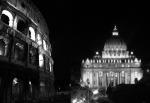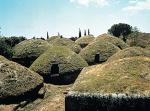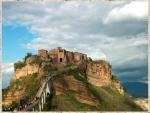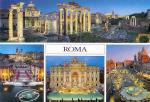LAST GUIDES VIEWED
Guide

Tours
1 : Flavours of Rome- Fullday - 1 day2 : Vatican museums, Sistine Chapel and St Peter Basilica - 1 day
3 : Etruscan tour – The necropolis of Cerveteri - 1 day
4 : Ancient Rome in Half Day - 1 day
5 : Umbria and Latium in a day - 1 day
6 : Baroc Piazzas and Fountains of Rome: La Dolce Vita in a Half Day - 1 day
Whether you are a first time visitor or seasoned traveller, as a qualified Guide I aim to help make your visit interesting and unique, through my skills both of entertainment and guiding to make any tour very enjoyable and educational. My tour include what's world famous but also what's less known. A less invasive type of tourism, with slowly paced tours, less crowded places - off the beaten path- whenever possible and special stops.
I can suggest tours or help you plan that exclusive, individual and personal itinerary which is exactly to your liking (or dedicated to your interests), informative, and above all, fun. I guide you in Rome or further a-field into our superb countryside, visiting other fine towns, archeological sights and hilltop-villages.
INSIDE & IN-DEPTH: I am permitted to guide inside Rome's major attractions. (Vatican Musuem, Sistine chapel, St. Peter, Roman forum, Colosseum, palatine Hill, Borghese Art Gallery, Villa Giulia Etruscan Muesum, Ancient Ostia, Tivoli Gardens, Hadrian Villas, etc)
SOMETHING DIFFERENT: I can organize several activities, like cooking classes, musical evening, dinners, traditional folk shows, musical tours, classical music concerts, treasure hunts, vespa scooter tours, horse-charriots tours, golf-cart tours, bike or rollerblades tours and any kind of events (wedding, anniversaries and special occasions).
About the guide
Activities
Cultural tour guideDriver-guide
Speaking languages
English, French, Spanish, Italian, Portuguese Activity started in
1995
Car
From car to minivanAir conditioned : YES
Baby seat : NO
Interests centers
-
Diploma, references, agreements
EDUCATIONAL HISTORY2005-2008
Rome and its province (Roman shire): Local Guide
oct 1999 jan 2000
Technical Director of Travel Agency (European licence);
1990-1992
Tour Operator (High School diploma), IPS “Stendhal”, Rome;
1988-1990
Tour Leading (Hign school certificate), Rome;
1986-1988
Scientific Liceum (biennio),
License or certificate (click to enlarge)

Services



















Tailor-made tours, Car, Boat, Sailing boat, Family / Children, Disabled, Culture, Unusual, Festival, Gastronomy, Fair tourism, Industrial tourism, Ecology, Wild animals, Horse, Bicycle, Kayak / raft, Speleo, Canyoning



















Contact
Contact - Get a quoteWeb site : www.pontuali.com/marco
Address : Via Diocleziano 39 Anguillara Sabazia 00061 Rome ITALY
Phone : (+39) 0699962761
Mobile : (+39) 333.4310145
Tours
This Full day itinerary will enable you to discover the town's best known treasures such as Vatican City, St. Peter Basilica, The Colosseum, Roman Forum and the Arch of Titus, The Arch of Costantine, The wedding cake building, Venice Square and much more.
Explore the famous ancient ruins, reflecting twelve centuries of Roman cultural, political and religious history, as your guide escorts you through the ruins of Imperial Rome. Visit the Roman Forum, the heart of ancient Rome, where the creation of the Roman civilization is reflected in the vast ensemble of ruins. Walk through Via Sacra (Sacred Way), the route followed by religious and triumphal processions. The imposing triumphal Arch of Titus was erected in 81 AD by the Emperor Domitian in honor of the victories in battle of his brother and father in Judea. A symbol of the "Eternal City," the Roman Colosseum is one of the most important monuments of ancient Rome. There, you'll have time for photographs outside the Colosseum. You will also see the impressive Arch of Constantine.
You will have free time for lunch, or the opportunity to join an optional typical lunch in a local restaurant.
Afterwards, drive to the Vatican City to visit St. Peter's Basilica, the largest church in the world. Among the many fine pieces of art on display are Michelangelo's "Pieta" and the beautifully carved Bernini Pulpit. A brief time will be allotted for you to explore or shop at your leisure.
Note: A guide will be on the coach during the trip to/from Rome. Guests must be able to walk approximately 2 miles over even and cobblestone surfaces with extended periods of standing and approximately 50 steps. A strict dress code is enforced in St. Peter's Basilica. Short pants, tank tops and revealing clothing are not acceptable. Guests may be required to check large bags, backpacks, video cameras and/or personal water bottles at designated check points.
Explore the famous ancient ruins, reflecting twelve centuries of Roman cultural, political and religious history, as your guide escorts you through the ruins of Imperial Rome. Visit the Roman Forum, the heart of ancient Rome, where the creation of the Roman civilization is reflected in the vast ensemble of ruins. Walk through Via Sacra (Sacred Way), the route followed by religious and triumphal processions. The imposing triumphal Arch of Titus was erected in 81 AD by the Emperor Domitian in honor of the victories in battle of his brother and father in Judea. A symbol of the "Eternal City," the Roman Colosseum is one of the most important monuments of ancient Rome. There, you'll have time for photographs outside the Colosseum. You will also see the impressive Arch of Constantine.
You will have free time for lunch, or the opportunity to join an optional typical lunch in a local restaurant.
Afterwards, drive to the Vatican City to visit St. Peter's Basilica, the largest church in the world. Among the many fine pieces of art on display are Michelangelo's "Pieta" and the beautifully carved Bernini Pulpit. A brief time will be allotted for you to explore or shop at your leisure.
Note: A guide will be on the coach during the trip to/from Rome. Guests must be able to walk approximately 2 miles over even and cobblestone surfaces with extended periods of standing and approximately 50 steps. A strict dress code is enforced in St. Peter's Basilica. Short pants, tank tops and revealing clothing are not acceptable. Guests may be required to check large bags, backpacks, video cameras and/or personal water bottles at designated check points.
Activities, services on this tour:










Tailor-made tours, Car, Family / Children, Disabled, Culture, Unusual, Fair tourism, Ecology, Wild animals, Speleo










Tailor-made tours, Car, Family / Children, Disabled, Culture, Unusual, Fair tourism, Ecology, Wild animals, Speleo
The tour starts from Vatican Museums: we enter the Pinefruit Courtyard, crossing the collection of greek and roman sculptures, admiring the famous staute of Apollus, the Laocoon and the Belvedere Torso, the statues of animals, the Coffins of St. Helen and St. Constance, the Galleries of Tapestries and the frescoed Maps of all Italy painted in 1585. The Rooms painted by Raphael and his pupils, ending with the amazing Michelangelo’s Sixtine Chapel. Michelangelo worked to fresco the vault of the Sistine Chapel from 1508 to 1512. Michelangelo expanded the project beyond the presentation of the twelve apostles originally commissioned by the pope Giulio 2nd to more than 300 figures. In this way, Michelangelo was able to give creativity to what is defined as the greatest masterpiece of the Italian Renaissance.
Afterward the tour will lead you inside the highest temple of Christendom: St. Peter’s Basilica. More than a simple church the Basilica, originally build by Emperor Constantine over the tomb of the very first pope, the apostle Peter, was designed by the best Italian architects. Its building took more than 150 years, and under a centain point of view is still a “work in progress”.
As soon as you eneter the basilica, you can admire the beautiful marble floors, and ceilings. The Pietà by Michelangelo, the Jubilee Gate, Bernini’s main altar, the staircase enlightened by eternal lamps leading to the tomb of Saint Peter designed by Carlo Maderno, the tombs of the Popes made by Bernini, Della Porta, Canova, Thorwaldsen and many others, Michelangelo’s amazing dome and more masterpieces will overhelm you. Ending with a quick view of Saint Angel Castle, and the secret wall connectig with the papal apartment, will give you the complete picture of the headquarter of Roman Catholic Church.
There is a saying in Rome for people who take their time in finishing things, “you take as long as it took St. Peter’s to be built”. To this one can respond, “Rome wasn’t built in a day”.
Afterward the tour will lead you inside the highest temple of Christendom: St. Peter’s Basilica. More than a simple church the Basilica, originally build by Emperor Constantine over the tomb of the very first pope, the apostle Peter, was designed by the best Italian architects. Its building took more than 150 years, and under a centain point of view is still a “work in progress”.
As soon as you eneter the basilica, you can admire the beautiful marble floors, and ceilings. The Pietà by Michelangelo, the Jubilee Gate, Bernini’s main altar, the staircase enlightened by eternal lamps leading to the tomb of Saint Peter designed by Carlo Maderno, the tombs of the Popes made by Bernini, Della Porta, Canova, Thorwaldsen and many others, Michelangelo’s amazing dome and more masterpieces will overhelm you. Ending with a quick view of Saint Angel Castle, and the secret wall connectig with the papal apartment, will give you the complete picture of the headquarter of Roman Catholic Church.
There is a saying in Rome for people who take their time in finishing things, “you take as long as it took St. Peter’s to be built”. To this one can respond, “Rome wasn’t built in a day”.
Activities, services on this tour:





Tailor-made tours, Car, Family / Children, Culture, Unusual





Tailor-made tours, Car, Family / Children, Culture, Unusual
Attracted by the mineral wealth found in the regions of Tuscany, Lazio and Umbria, the Etruscans made their way to Italy around 900 BC. Traces of Etruscan civilisation can be found in their burial sites and in the artefacts found in their tombs. They were preoccupied with the afterlife and dedicated much effort in building burial sites carved into rock or constructed from stone slab and reached by dedicated rock-cut roads.
For an exploration of Etruscan artefacts we will start in the valley of CERVETERI, where about 2000 Etruscan tombs among the most famous in the world can be found. We enter the necropolis Necropoli della Banditaccia, which has been declared by UNESCO a World Heritage Site and where we will explore the most important typologies of tombs from the IX to the II century B.C. It covers an area of 400 ha, of which 10 ha can be visited, encompassing a total of 1,000 tombs often housed in characteristic mounds. It is the largest ancient necropolis in the Mediterranean area. The necropolis is a city of the dead which bears impressive witness, in the scale of the necropolis and the richness of the buried goods, to the importance attached by the Etruscans to the cult of the dead. On either side of a ''main street'' some 2km/1.5mi long, with a number of side streets, lie hundreds of tombs, including huge tumuli up to 30m/99ft in diameter and many tomb chambers hewn from the rock in the form of dwelling-houses, often with several rooms, with frescoes like the Tomb of Rilievi decorated with plaster reliefs of mythological figures.
The necropolises of Cerveteri is a masterpiece of creative genius that reveals aspects of life, death, and religious beliefs of the ancient Etruscans.
Cerveteri shows in a funerary context the same town planning and architectural schemes used in an ancient city. It constitute a unique and exceptional testimony to the ancient Etruscan civilisation, the only urban type of civilisation in pre-Roman Italy.
Many of the tombs of Cerveteri represent types of buildings which no longer exist in any other form. The cemeteries, replicas of Etruscan town planning schemes, are some of the earliest existing in the region.
Optional extension of the guided tour to the Etruscan Museums that contains a selection of Etruscan artefacts that were found in tombs nearby. The best finds now can be seen in the Museo Nazionale Cerite near the modern city of Cerveteri or at Vatican Museum or at Villa Giulia in Rome
For an exploration of Etruscan artefacts we will start in the valley of CERVETERI, where about 2000 Etruscan tombs among the most famous in the world can be found. We enter the necropolis Necropoli della Banditaccia, which has been declared by UNESCO a World Heritage Site and where we will explore the most important typologies of tombs from the IX to the II century B.C. It covers an area of 400 ha, of which 10 ha can be visited, encompassing a total of 1,000 tombs often housed in characteristic mounds. It is the largest ancient necropolis in the Mediterranean area. The necropolis is a city of the dead which bears impressive witness, in the scale of the necropolis and the richness of the buried goods, to the importance attached by the Etruscans to the cult of the dead. On either side of a ''main street'' some 2km/1.5mi long, with a number of side streets, lie hundreds of tombs, including huge tumuli up to 30m/99ft in diameter and many tomb chambers hewn from the rock in the form of dwelling-houses, often with several rooms, with frescoes like the Tomb of Rilievi decorated with plaster reliefs of mythological figures.
The necropolises of Cerveteri is a masterpiece of creative genius that reveals aspects of life, death, and religious beliefs of the ancient Etruscans.
Cerveteri shows in a funerary context the same town planning and architectural schemes used in an ancient city. It constitute a unique and exceptional testimony to the ancient Etruscan civilisation, the only urban type of civilisation in pre-Roman Italy.
Many of the tombs of Cerveteri represent types of buildings which no longer exist in any other form. The cemeteries, replicas of Etruscan town planning schemes, are some of the earliest existing in the region.
Optional extension of the guided tour to the Etruscan Museums that contains a selection of Etruscan artefacts that were found in tombs nearby. The best finds now can be seen in the Museo Nazionale Cerite near the modern city of Cerveteri or at Vatican Museum or at Villa Giulia in Rome
Activities, services on this tour:







Car, Family / Children, Disabled, Culture, Unusual, Ecology, Birdwatching







Car, Family / Children, Disabled, Culture, Unusual, Ecology, Birdwatching
From Venice Sqaure, overshadowed by a monument dedicated to Vittorio Emanuele II that was built also to commemorate Italian unification and that incomrporates the tomb of the unknown soldier, and the 15th century Palazzo Venezia, which was Mussolini’s official residence, we will walk to the Roman Forum, the commercial, political and religious centre of ancient Rome, the forum stands in a valley between the Capitoline and Palatine hills. Each side is dedicated to an emperor, we will visit its temples, monuments and buildings constructed by successive emperors, consuls and senators over a period of 900 years. We’ll walk through the Via Sacra (Holy Road) to admire Tempio di Antonino e Faustina, erected by the Senate in 141 AD and transformed into a church in the 8th century, the Basilica Aemilia, built in 179 BC, the Curia, once the meeting place of the Roman Senate, the Lapis Niger, which legend says covered the grave of Romulus.
We will visit the Arco di Settimio Severo, erected in 203 AD in honour of this emperor and his sons, and is considered one of Italy’s major triumphal arches, the Rostrum, used in ancient times by public speakers and once decorated by the rams of captured ships, the Tempio di Saturno, one of the most important temples in ancient Rome, the Basilica Julia, the ancient seat of justice, the Temple of Julius Caesar, which was erected by Augustus in 29 BC on the site where Caesar’s body was burned and Mark Antony read his famous speech, Tempio dei Castori, built in 489 BC to mark the defeat of the Etruscan Tarquins, the Home fo the virgins Vestals who tended the sacred flame in the adjoining Tempio di Vesta. After a stop by the vast Basilica di Costantino, which its impressive design inspired Renaissance architects, we will pass through the Arco di Tito, built in 81 AD and at the end of the Forum.
We then will descend to the Arch of Costantine, built to honour Constantine, in 312 AD, its decorative reliefs were taken from earlier structures, and finally the Colosseum, the most important building of ancient times, originally known as the Flavian Amphiteatre, its construction was started by Emperor Vespasian in 72 AD in the grounds of Nero’s Golden House, and completed by his son Titus. The massive structure could seat 80.000 and the bloody gladiator combat and wild beast shows, when thousands of wild animals were slashed to death, give some insight into Roman people of the day.
We will visit the Arco di Settimio Severo, erected in 203 AD in honour of this emperor and his sons, and is considered one of Italy’s major triumphal arches, the Rostrum, used in ancient times by public speakers and once decorated by the rams of captured ships, the Tempio di Saturno, one of the most important temples in ancient Rome, the Basilica Julia, the ancient seat of justice, the Temple of Julius Caesar, which was erected by Augustus in 29 BC on the site where Caesar’s body was burned and Mark Antony read his famous speech, Tempio dei Castori, built in 489 BC to mark the defeat of the Etruscan Tarquins, the Home fo the virgins Vestals who tended the sacred flame in the adjoining Tempio di Vesta. After a stop by the vast Basilica di Costantino, which its impressive design inspired Renaissance architects, we will pass through the Arco di Tito, built in 81 AD and at the end of the Forum.
We then will descend to the Arch of Costantine, built to honour Constantine, in 312 AD, its decorative reliefs were taken from earlier structures, and finally the Colosseum, the most important building of ancient times, originally known as the Flavian Amphiteatre, its construction was started by Emperor Vespasian in 72 AD in the grounds of Nero’s Golden House, and completed by his son Titus. The massive structure could seat 80.000 and the bloody gladiator combat and wild beast shows, when thousands of wild animals were slashed to death, give some insight into Roman people of the day.
Activities, services on this tour:



Tailor-made tours, Culture, Fair tourism



Tailor-made tours, Culture, Fair tourism
A chance to spend a delightful day to visit Umbira and Latium, two of the most picturesque regions of Italy rich in vineyards, olive trees and the famous hill-top villages across the valley.
We will drive to Orvieto, an ancient Etruscan city perched on a volcanic tufa summit that rises 1,000 feet above the river Paglia. The town has a medieval atmosphere, looking much like it did 500 years ago. Once an Etruscan stronghold, Orvieto has many archeological findings. We will explore the narrow streets around the Piazza del Duomo and visit its unique Cathedral.
We will then continue to Civita di Bagnoreggio, nicknamed ''the city that dies'', a charming hilltown which has a permanent population of only 15 people who proudly share their village and its Etruscan and Roman roots. We will wander the cobblestone streets lined with stones homes while admiring the expansive canyon views.
Departures from Rome, its surrounding, Civitavecchia Port, Fiumicino airpot.
We will drive to Orvieto, an ancient Etruscan city perched on a volcanic tufa summit that rises 1,000 feet above the river Paglia. The town has a medieval atmosphere, looking much like it did 500 years ago. Once an Etruscan stronghold, Orvieto has many archeological findings. We will explore the narrow streets around the Piazza del Duomo and visit its unique Cathedral.
We will then continue to Civita di Bagnoreggio, nicknamed ''the city that dies'', a charming hilltown which has a permanent population of only 15 people who proudly share their village and its Etruscan and Roman roots. We will wander the cobblestone streets lined with stones homes while admiring the expansive canyon views.
Departures from Rome, its surrounding, Civitavecchia Port, Fiumicino airpot.
Activities, services on this tour:











Tailor-made tours, Car, Family / Children, Disabled, Culture, Unusual, Gastronomy, Ecology, Excursion / trekking, Mountain, Speleo











Tailor-made tours, Car, Family / Children, Disabled, Culture, Unusual, Gastronomy, Ecology, Excursion / trekking, Mountain, Speleo
In a fascinating walking tour of the historical centre you’ll admire and learn the history and stories behind the walls of the most important monuments of the baroc city. As we walk through the enchanting streets and piazzas of Rome, we’ll discuss the ideas of the Renaissance and Baroque, the lives of the famous artists, and the several rich popes and families who showered the city with countless masterpieces, setting precedents of artistic standard for centuries to come.
We’ll pause to admire the Trevi’s fountain, the most spectacular among the fountains of Rome. We will continue to the Spanish Steps to discuss the legend and history of the most scenic staircase in Rome, a fundamental reference point for visitors and local people. After crossing the fashion district and thew elegant shopping center in an fine and noble Galleria we’ll reach Piazza Colonna with its ancient column in the middle built by the Roman Senate in 118 AD to honour Marcus Aurelius victories, sourrended by elegant palaces such as Palazzo Chigi (today is the seat of the Prime Minister’s office.
We’ll cross Montecitorio square where the palace, built by Bernini and used today as seat of the Italian Government, arises together with one of Rome’s high obelisks.
After enjoying the walking tour through the historical centre we will arrive at the Pantheon, the best preserved rman temple.
The tour finishes in Piazza Navona where you will be able to take some time to reflect on Bernini and Borromini’s genius as right here there are the best work of both artists, sitting in one of the cafes around the square, or on a bench to admire local artists, eating a gelato.
Please note that you can customize the tour, invert the order, add other things.
A private vehicle can be arranged upon request.
This tour can be combined with other Half Day Tours.
We’ll pause to admire the Trevi’s fountain, the most spectacular among the fountains of Rome. We will continue to the Spanish Steps to discuss the legend and history of the most scenic staircase in Rome, a fundamental reference point for visitors and local people. After crossing the fashion district and thew elegant shopping center in an fine and noble Galleria we’ll reach Piazza Colonna with its ancient column in the middle built by the Roman Senate in 118 AD to honour Marcus Aurelius victories, sourrended by elegant palaces such as Palazzo Chigi (today is the seat of the Prime Minister’s office.
We’ll cross Montecitorio square where the palace, built by Bernini and used today as seat of the Italian Government, arises together with one of Rome’s high obelisks.
After enjoying the walking tour through the historical centre we will arrive at the Pantheon, the best preserved rman temple.
The tour finishes in Piazza Navona where you will be able to take some time to reflect on Bernini and Borromini’s genius as right here there are the best work of both artists, sitting in one of the cafes around the square, or on a bench to admire local artists, eating a gelato.
Please note that you can customize the tour, invert the order, add other things.
A private vehicle can be arranged upon request.
This tour can be combined with other Half Day Tours.
Activities, services on this tour:





Tailor-made tours, Family / Children, Disabled, Culture, Fair tourism





Tailor-made tours, Family / Children, Disabled, Culture, Fair tourism
Location
Click on the links to locate positions
 guide
guide
 Flavours of Rome- Fullday
Flavours of Rome- Fullday  Vatican museums, Sistine Chapel and St Peter Basil
Vatican museums, Sistine Chapel and St Peter Basil  Etruscan tour – The necropolis of Cerveteri
Etruscan tour – The necropolis of Cerveteri  Ancient Rome in Half Day
Ancient Rome in Half Day  Umbria and Latium in a day
Umbria and Latium in a day  Baroc Piazzas and Fountains of Rome: La Dolce Vita
Baroc Piazzas and Fountains of Rome: La Dolce Vita
 guide
guide  Flavours of Rome- Fullday
Flavours of Rome- Fullday  Vatican museums, Sistine Chapel and St Peter Basil
Vatican museums, Sistine Chapel and St Peter Basil  Etruscan tour – The necropolis of Cerveteri
Etruscan tour – The necropolis of Cerveteri  Ancient Rome in Half Day
Ancient Rome in Half Day  Umbria and Latium in a day
Umbria and Latium in a day  Baroc Piazzas and Fountains of Rome: La Dolce Vita
Baroc Piazzas and Fountains of Rome: La Dolce Vita
Guides around
Links
 Guides in Rome
Guides in Rome  Italy private guides
Italy private guides Italy : private guides speaking English
Italy : private guides speaking English Europe private guides
Europe private guides




 Medium
Medium 
 Easy
Easy 









